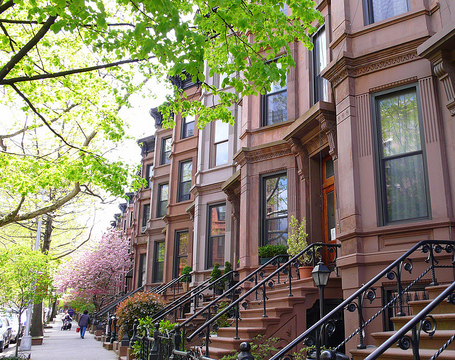

Brownstone is a brown Triassic or Jurassic[citation needed] sandstone which was once a popular building material. The term is also used in the United States to refer to a terraced house (rowhouse) clad in this material.
Five-story brownstones in Harlem, just south of 125th Street, 2004
Types
The Barbour County Courthouse (1903-05) in Philippi, West Virginia is faced entirely in Hummelstown brownstone
Apostle Island brownstone
In the 19th century, Basswood Island, Wisconsin, was the site of a quarry run by the Bass Island Brownstone Company which operated from 1868 into the 1890s. The brownstone from this and other Apostle Islands quarries was in great demand, and brownstone from Basswood Island was used in the construction of the first Milwaukee County Courthouse in the 1860s.[1]
Hummelstown brownstone
Hummelstown brownstone is extremely popular along the East Coast of the United States of America, with numerous government buildings from West Virginia, Pennsylvania, New York, Maryland, and Delaware being faced entirely with the stone. The stone comes from the Hummelstown Quarry in Hummelstown, Pennsylvania, a small town outside of Harrisburg, Pennsylvania. The Hummelstown Quarry is the largest provider of brownstone on the east coast. Typically the stone was transported out of Hummelstown through the Brownstone and Middletown Railroad or taken by truck up to the Erie Canal.[citation needed]
Portland brownston
Portland brownstone is also very popular. The stone from quarries located in Portland, Connecticut and other nearby localities was used in a number of landmark buildings in Chicago, Boston, New York City, Philadelphia, New Haven, Connecticut, and Hartford, Connecticut.
New Jersey brownstone
At Rutgers University, Old Queen's, built 1809–1823, was constructed from ashlar brownstone quarried in the hills near New Brunswick, New Jersey.
Quarries from the Passaic Formation in northern New Jersey once supplied most of the brownstone used in New York City and in New Jersey itself.[2]
There are many brownstones throughout numerous New York City neighborhoods, especially in the Brooklyn neighborhoods of Park Slope, Clinton Hill, Fort Greene, Cobble Hill, Prospect Heights, Brooklyn Heights, and Bedford Stuyvesant. The Manhattan neighborhood of the Upper West Side, too, retains many brownstones. New York City brownstones are highly desired, and usually cost several million dollars to purchase.
Victorian brownstone homes — considered one of the best-preserved examples of 19th-century urban design in the United States — as well as numerous architecturally significant individual buildings and important cultural institutions is located in Boston's Back Bay neighborhood.[3]
Although some brownstones exist in Chicago, a similar residential form known as "greystones" are by far more prevalent. A greystone is a type of residential structure that utilizes Indiana limestone for its facade, regardless of its overall architectural style. As in Brooklyn, there exists a "Greystone Belt" in Chicago, with large numbers of such structures located in the south and northwest quadrants of the city. It is estimated that around 30,000 of Chicago's greystones built between 1890 and 1930 are still standing.[4]
Brownstone, also known as freestone due to its durability and advantages as a building material, was used by early Quakers in Pennsylvania to construct stone mills and mill houses. In central Pennsylvania, some 1700s-era structures survive, including one still used as a residence, known as the Quaker Mill House.



















